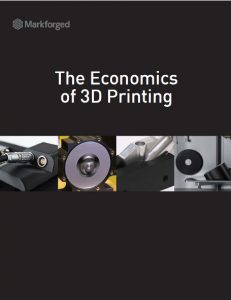Read This if ROI is King at Your Company

The white paper, “The Economics of 3D Printing,” uses real numbers and a set of easy-to-use equations that can help you determine the return on your investment in a production-grade 3D printing system. Image courtesy of Markforged Inc.
Latest News
May 25, 2017
So the division president at the zillion-dollar publishing house calls to ask if using this internet thing to provide media content is going anywhere. We said it was and that it would disrupt traditional hard-copy business models. We groveled for continued funding. We were promptly sold off. He couldn’t justify the ROI (return on investment) for the investment, and our argument was nerdy weak. Something like the paper at the far end of today’s Check it Out link would have strengthened our case.
 The white paper, “The Economics of 3D Printing,” uses real numbers and a set of easy-to-use equations that can help you determine the return on your investment in a production-grade 3D printing system. Image courtesy of Markforged Inc.
The white paper, “The Economics of 3D Printing,” uses real numbers and a set of easy-to-use equations that can help you determine the return on your investment in a production-grade 3D printing system. Image courtesy of Markforged Inc.“The Economics of 3D Printing” from Markforged is a terrific resource for visionary designers, engineers and makers who understand the potential economic impact of 3D printing for production use but face skeptical management that demands to see the ROI for such an investment. Although written to help you to devise your pitch for in-house 3D printing, it’s really written for money people by a money person who gets that 3D printing is a disruptive production technology that’ll leave traditional business models reeling.
There are three keys to this paper: real money numbers, a handful of equations that anyone can use to calculate ROI for themselves and realistic examples. An aside: Get real numbers and you can easily apply this paper’s methodology to any 3D printing platform or technology that could provide your outfit cost efficiencies and improved operations.
The example is a simple brake lever. Its 3D-printed manufacturing cost is compared with milling or injection molding the same part in-house or through an external service. But it’s the real numbers and formulas that shine.
The paper includes in its calculations – kudos here – the actual price for a Mark Two 3D Printer and the amount as well as the true cost of the materials to build the part. You can even get today’s pricing on Markforged’s website. It calculates the cost for alternative manufacturing methods fairly. The two sets of numbers are then compared, the break-even point determined and the ROI and potential gain on investment calculated.
It’s that simple. The results are eye-openers. Further buttressing the money angle is a quick side testimonial that adds a riff on time saved through in-house 3D printing versus alternative methods.
All in all, “The Economics of 3D Printing” is well done. It’s a keeper. Hit today’s Check it Out link to get your copy, start running some numbers and set up a meeting with the boss.
Thanks, Pal. – Lockwood
Anthony J. Lockwood
Editor at Large, DE
Subscribe to our FREE magazine, FREE email newsletters or both!
Latest News
About the Author
Anthony J. Lockwood is Digital Engineering’s founding editor. He is now retired. Contact him via [email protected].
Follow DE







